
Centre of Jaina Studies Newsletter: SOAS - University of London
he 16th Jaina Studies Workshop, hosted by the SOAS Centre for Jaina Studies, was held 21 March 2014. It coincided with the ten-year anniversary of the Centre's founding. The theme was Jaina Hagiography and Biography. On the evening prior to the workshop, Dr Saryu Doshi, formerly Honorary Director of the National Gallery of Modern Art in Mumbai, delivered the 14th annual lecture entitled Life of Ṛṣabha: A Painted Vision.
Doshi's presentation featured a magnificent painted scroll that she had discovered some forty years ago in the storeroom of a Digambara temple in Karanja. The five auspicious moments (pañca-kalyānaka) in the life of Ṛṣabha are featured on this scroll, and the illustrations are most likely based on the biography of Ṛṣabha in the Ādipurāṇa of Jinasena. The style, however, incorporates features of the clothing, the towns and the palaces, and so forth that are representative of the social situations and historical circumstances of the time and place where the scroll was painted. The illustrations also have some unique features, such as the depiction of the elephant Airavata, who transports Indra to Mount Meru for the lustration rites of the infant, with multiple tusks and lotuses. After describing the various scenes found on the manuscript, Doshi discussed certain elements in the paintings that provide clues to where this scroll was painted. At first she thought it had been painted in Rajasthan, perhaps in Bundi, because there were many features that allied it to Bundi paintings. However, she noticed that there were elements that allied it to Deccani paintings. In the seventeenth century, people from Rajasthan had settled in the Deccan, particularly in Aurangabad, to serve the chieftains from Rajasthan who had come to fight in the Deccani wars. They probably had brought their courts with them, including painters and a mixed Rajasthani and Deccani style of painting developed here. A number of Jains who were tradespeople came to supply goods to the Mughal army and Rajasthani nobelmen involved in the Mughal wars. Among them were Jains from Bundi who did not intermarry with families in the Deccan and thus remained clanish. These Agarwals were associated with the temple in Karanja where the scroll was found, which was the seat of the bhaṭṭāraka of the Sena Gaṇa. Doshi concludes that this community invited an artist from Aurangabad with Bundi affiliations to paint a scroll for them, which accounts for the mixed style found in the paintings.
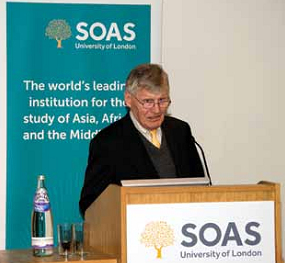
Introduction of the Keynote Speaker: Robert Skelton, O.B.E., Keeper of the Indian Department of the V&A Museum from 1978 to 1988
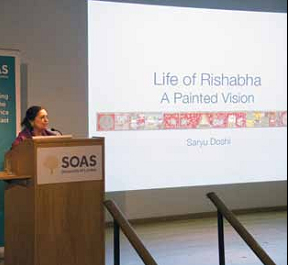
Saryu Doshi
Doshi's presentation, which visually transported the audience back to the beginning of the fourth period in the descending cycle of time when the celebrations of the auspicious moments in the life of the first Tīrthaṅkara of the era took place, set the stage for the next morning when aspects of biographies of Ṛṣabha were discussed in the context of the Hindu purāṇas, Śatruñjaya, and Mount Meru. The biographies of the first vāsudeva, baladeva, and prativāsudeva of our era were examined in the context of why a biography would be presented twice. Moving into the fifth period, there were discussions of the lives of four Śvetāmbara Mūrtipūjak mendicants: Jinaprabhasūri of the Kharatara Gaccha, who lived in medieval times; and Ācārya Rāmacandrasūri, Muni Jambūvijaya, and Sādhvī Divyaprabhāśrī, who took dīkṣā in the Tapā Gaccha in the twentieth century. The practice of collecting material for biographical works within the Śvetāmbara Terāpanthī community was discussed in the context of Ācārya Tulsī, their ninth mendicant leader. There were two presentations that were not focused on illustrious men (śalākapuruṣa) or historical figures. One discussed hagiographic writings on North Indian bhaṭṭārakas, and the other explored the ways in which hagiographies were used during rituals associated with modes of dying found in Ārādhanā texts. The day ended with a report on work that is underway at SOAS on the manuscript of Johannes Klatt's Jaina Onomasticon, an encyclopedic 120-year-old bio-bibliographical resource, whose manuscript lay half-forgotten in the Asia-Africa Institute in Hamburg.
At the workshop the following day Renate SöhnenThieme (SOAS) focused on biographies of Ṛṣabha and his son Bharata in the Hindu purāṇas. She observed that although much has been written about how biographies from Brahmanical literature, such as the Harivaṃśapurāṇa, have been incorporated into the universal history of the Jains, little attention has been paid to the opposite process, except for Padmanabh Jaini's articles on Ṛṣabha in the Bhāgavata-purāṇa, where he becomes an avatāra of Viṣṇu. Jaini has concluded that the source of this material was Jinasena's Ādipurāṇa. There is, however, mention of Ṛṣabha in earlier Hindu purāṇas, including the Viṣṇu-purāṇa, which was an important source for the Bhāgavata. The Viṣṇu-purāṇa must have been acquainted with some aspects of the Jain tradition because in the narrative, the term vīra is used, along with arahanta, and the practice of nudity is also mentioned. While the criticism of brāhmaṇs in the Bhāgavata are no doubt associated with the Ādipurāṇa, other details could have come from elsewhere, perhaps the Kalpa Sūtra, Jambūdvīpaprajñapti, or the Āvaśyakaniryukti, in which Ṛṣabha and Bharata are first linked. The absence of Bāhubali in the Bhāgavata also calls into the question assumptions regarding the Ādipurāṇa. Given the problems of relative dating of the various texts, SöhnenThieme concluded that it is not evident what the Jaina sources might have been, and determining who borrowed from whom is problematic as well, but the influence of earlier Jaina sources on the Bhāgavata is undeniable.
Eva de Clerq (University of Ghent) examined changes in biographies of Ṛṣabha among the Śvetāmbaras and the rise of Śatruñjaya as the most famous sacred site for Śvetāmbaras. In the vast corpus of early biographies of Ṛṣabha, aside from the number of dreams and the number of kulakaras, there is little variation in Śvetāmbara and Digambara sources except for the sequencing of events. All agree that after Ṛṣabha attained omniscience on Mount Aṣṭāpada (often identified with Mount Kailāsa), Ṛṣabhasena/Vṛṣabhasena became the first of his eightyfour gaṇadharas. In the course of his subsequent wanderings, there is no mention of Ṛṣabha visiting Mount Śatruñjaya in either Śvetāmbara or Digambara sources. From the fifth century onwards, however, in both traditions, Śatruñjaya is known as the place where the five Pāṇḍavas attained liberation. Although it was not associated with any of the Tīrthaṅkaras or other illustrious individuals (śalākā-puruṣa), it was worthy of respect because it was a place of liberation (siddha-kṣetra). Beginning in the eleventh century, when Śatruñjaya was becoming an important Śvetāmbara pilgrimage site, there are significant changes in the Ṛṣabha narrative in Śvetāmbara sources. His first gaṇadhara is either known exclusively as Puṇḍarīka, or this name is used alternatively with Ṛṣabhasena. In his wanderings after attaining omniscience, Ṛṣabha and his mendicant followers visit Śatruñjaya, and both Ṛṣabha and Pundarīka preach in the assembly hall there. According to Hemacandra's account, Ṛṣabha tells Pundarīka to remain on Śatruñjaya because he and the others monks staying there will attain liberation "from the power of the place." Because it was the first tīrtha, Śatruñjaya, where Bharata had erected a shrine and installed images of Ṛṣabha and Puṇḍarīka, attained an elevated status among Śvetāmbaras, and by using alternate names, there is a distancing of this mountain in the context of the liberation of the Pāṇḍavas. For Digambaras, there was no elevation in status of Śatruñjaya. It remained a siddha-kṣetra that was never visited by Ṛṣabha.
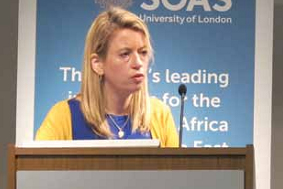
Eva de Clercq
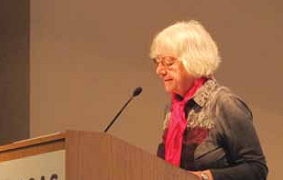
Renate Söhnen-Thieme (SOAS)
Ruth Satinsky (University of Lausanne) discussed what the lifespans of Ṛṣabha and Bharata (8,400,000 pūrva), Śreyāṃsa (8,400,000 years), and Ara (84,000 years) might reveal about the history of the concept of Mount Meru and its appearance in Hindu cosmology. In Jain cosmology, there are five Merus, and the lives of the Tīrthaṅkaras are linked to them through the lustration ceremonies that are performed on their summits by the gods. A further link is found with the four Merus that are on the island-continents inhabited by humans other than Jambūdvīpa because they each rise 84,000 yojanas above the earth. In Pali texts of the Buddhist canon, Mount Meru also rises 84,000 yojanas above the earth. Kirfel has maintained that early Brahmanical cosmology formed the basis of later cosmology found in the epics and purāṇas and was the basis for cosmology in Jaina and Buddhist texts as well. However, Satinsky questions this because Mount Meru is first mentioned in the Bhīṣmaparvan of the Mahābhārata. Also, the concept of 84 and its multiples is absent in early Brahmanical literature, although Satinsky claims that it was widespread in the Greater Magadha region. Among the Jains, the number 8,400,000 signifies the number of places of hell, the number of life forms into which a soul may be born, and the number of mahākalpas through which a soul must pass throughout saṃsāra. This corresponds with a similar notion among the Ajīvikas of 8,400,000 as the sum total of birth situations that a soul must experience. Thus, Satinsky has concluded that the concept of Mount Meru, along with the number eightyfour and its multiples, may have entered Hindu works under the influence of the culture of Greater Magadha.

(Left to right) Peter Flügel, Richard Black (SOAS Pro-Director Research & Enterprise), J.C. Wright, Robert Skelton & Saryu Doshi
Anna Esposito investigated why the biographies of Tiviṭṭhu (Skt. Tripṛṣṭha), along with his half-brother Ayala (Skt. Acala), and his enemy Āsaggīva (Skt. Aśvagrīva), the first vāsudeva, baladeva, and prativāsudeva of our era, are told twice in the Vasudevahiṇḍī of Saṅgadāsa (ca. fifth century CE). Tiviṭṭhu is an example of the intersection of lives of certain śalākāpuruṣas. Tiviṭṭhu was a contemporary of Sijjaṃsa (Skt. Śreyāmsa), the eleventh Tīrthaṅkara, and eventually his soul would take birth as Mahāvīra, the last Tīrthaṅkara of our era. Previously, his soul had attained birth as Marīi (Skt. Marīci), grandson of Usabha (Skt. Ṛṣabha), and son of Bharaha (Skt. Bharata), the first cakravartin. Tiviṭṭhu's daughter married Amiyateya (Skt. Amitatejas), who would be reborn as Sānti (Skt. Śanti), the sixteenth Tīrthaṅkara. Esposito noted that the narratives into which the biographies are embedded determine the character on which the story is focused. The first, which focuses on the life of Āsaggīva, explains why Prince Migaddhaya, unprovoked, cut off the foot of a buffalo. The prince in a past life had been Āsaggīva who had a minister named Harimaṃsu, a nāstika who advocated a materialistic world view. Āsaggīva wanted to marry the woman who became the wife of Tiviṭṭhu. A war commenced and Tiviṭṭhu killed Āsaggīva, becoming the first vāsudeva. Āsaggīva and his minister are both reborn in hell. Thinking he had come to destroy him, Āsaggīva develops an enmity towards his minister, which is played in many rebirths until the two are born as the prince and the buffalo. Esposito postulated that because of the emphasis is on the prativāsudeva here, Saṅgadāsa may have felt compelled to retell the story with an emphasis on the biography of the hero Tiviṭṭhu, creating an association by marriage between him and Sānti. Esposito stated that she has found no earlier source in which these two are linked and believes it may be the source of the story of Sānti's previous birth in later purānas and universal history texts.
Steven Vose (Florida International University) explored the question of how Jinaprabhasūri (12611333 CE), ācārya of the Laghu Śākhā of the Kharatara Gaccha, portrayed himself in his Vividhatīrthakalpa and how he was understood by his own lineage and by the Tapā Gaccha. Jinaprabha credits his skills as a debater and poet for his success with the sultan Muḥammad bīn Tughluq, who issued several edicts protecting Jains and their pilgrimage places, and who established near his own residence in Delhi a quarter for Jains with a new temple and upāśraya where Jinaprabhasūri could stay. Although today he is viewed as one of the most famous ācāryas in the Kharatara Gaccha, there is little mention of him in their accounts for around a century after this death. However, he appears in narratives of the Tapā Gaccha, where an emphasis is placed on his hymns and on his supernatural powers. In keeping with the Tapā Gaccha view, he expresses concerns that he had compromised his mendicant vows by his close association with the sultan, and he came to be viewed as one of their own. Vose theorizes that accounts of Jinaprabha's interactions with the sultan provided the narrative structure for the Tapā Gaccha's account of the association of Hīravijayasūri with the court of the Mughal emperor Akbar. Subsequently, Dharmasāgara took to task the Tapā Gaccha monks who had embraced a leader of a rival lineage as one of their own, and Jinaprabha faded into obscurity within this gaccha. On the other hand, he became prominent in subsequent compositions of the Kharatara Gaccha.
Andrea Luithle-Hardenberg (University of Tübingen) focused on a recently published Englishlanguage hagiography, The Call of the Soul, on life of Rāmacandrasūri (1897-1992), the founder of one of the largest Tapā Gaccha samudāyas. It was written by Jinaprajñā, a sādhvī in her forties who never met Rāmacandra personally. The topics where chosen, however, by Ācārya Kīrtiyaśasūri, who had been among the inner circle of his guru, and it is his point of view that is represented throughout the volume. The 108 anecdotes of Rāmacandrasūri's life contain a wide range of controversial subjects, which may be classified into five categories: his protests against the legal ban of initiation of children into mendicancy (bāl dīkṣā); his strict interpretations of ahiṃsā and his critique of Mohandās Gāndhī's views on this subject; his views regarding the astrological determination of festivals in the ritual calendar (pañcāṅga), which are at odds those of other Tapā Gaccha samudāyas; his view that temple donations should be used exclusively for images and temple maintenance, not for charitable projects or paying temple servants; and his views regarding modes of worship that are permissible for living and deceased ācāryas. Debates regarding these issues among mendicants are acceptable, but within the lay community such discussions are viewed as problematic, being at odds with the concepts of ahiṃsā and anekāntavāda. Thus, at first glance, it is surprising that these controversies are detailed in this hagiography, which was written for an audience of English-speaking upper middle class Jains, and for non-Jains as well. However, Luithle-Hardenberg concludes that they have been included here because they strengthen the claim for Ācārya Kīrtiyaśasūri's leadership of the Rāmacandrasūri samudāya.In her lecture entitled "Autobiographical and Biographical Accounts of Ācārya Tulsī" (1914-1997), the ninth head of the Terāpanth, Samaṇī Pratibhāprajñā (SOAS) raised the question of whether Merā Jīvana Merā Darśana ("My Life, My Vision") should be called an autobiography because only thirty pages are actually the ācārya's own words and these were dictated, not written. She provisionally concluded that it is an autobiography according to the definition "a narrative account of an extended period of a person's life written by, or presented as having been written by that person." These eighteen volumes, edited by Sādhvī Pramukhā Kanakaprabhā and published between 2002-2011, are primarily based on Tulsī's diaries. However, there is some material from other sources, such as felicitation volumes and articles in journals. Although the first volume was completed by Tulsī himself, the remainder was written by the editor. Samaṇī Pratibhāprajñā observed that the personalities of the ācārya and the editor are very different and questioned whether the editor could write in his tone. She believes that the editor's feelings and voice are sometimes discernible. For the most part, however, it is difficult for the reader to distinguish the voice of the editor, and the work appears to be written in Tulsī's own hand. It is invaluable as a source of history because his diary, which began in 1950 and ended the day of his death in 1997, contains accounts of his journeys spanning nearly fifty years. It provides a glimpse into the places he visited and the people he met, their personalities, and their lifestyles, at different times in history. Samaṇījī noted that this work must also be considered a biography because an account of Tulsī's death is included. She noted that although few people are familiar with this genre outside of the Jain community, there is a long tradition of biographies in the Terāpanth, beginning with their first leader, Ācārya Bhikṣu. In addition to this autobiography, four biographies have been written on Tulsī, one of which, Ācārya Mahāprajña's, has been translated into English as Wheel of Dharma.

Shin Fujunaga (Miyakonojō Kōsen) outlined the life of Muni Jambūvijaya (1923-2009) with an emphasis on his scholarship and discussed materials from which a biography could be constructed. Jambūvijaya took initiation 1937 at age fourteen from Muni Bhuvanvijaya, who had been his father in secular life. Within ten years, his abilities as a scholar had been recognized. Because of his knowledge of Tibetan, he was well-known in the field of Indology. Although his vows precluded him from traveling abroad, he was invited to contribute to the first international conference on Dharmakīrti at Vienna University. He edited a number of Jaina works, but in later years he focused his energies on preparing critical editions of the Jain āgamas and like Puṇyavijaya was interested in collecting manuscripts. Although he utilized commentaries in preparing critical editions published in the Jaina Āgama Series, only the source text was published. He maintained that commentaries were essential to understanding a text and decided to critically edit the all forty-five Jain āgamas with commentaries but he did not realize his dream due to his sudden death in 2009. There is no comprehensive biography of Jambūvijaya because he refused to allow one to be included in his Festschrift. However, materials are available from which one could be prepared. He kept a list where he spent his cāturmās from 1931-2009. Prefaces to his edited works are useful to understanding his attitude toward editing texts, and they record where he was staying when they were written. Scripture and Community contains the notes that Kendall W. Folkert made during his stay with Jambūvijaya during the rainy season of 1985. A collection of twenty-nine letters that Jambūvijaya wrote to Padyumnasūri during his pilgrimage in the Himalayas in 2001 (Himālay nī Padyātrā) records where he traveled and reveals how Jain mendicants travel in a region where very few Jains live. After Jambūvijaya's death, Ācārya Municandravijaya, who had lived with him for about twenty years, took over the task of publishing the āgamas with commentaries. In the Uvavāiasuttam he has written about Jambūvijaya's lineage and tells of his experiences with him. Fujinaga concluded his talk by asking all scholars who knew Jambūvijaya to share information about his life.

Paul Dundas, Shin Fujinaga & Whitney Kelting
Whitney Kelting (Northeastern University) discussed a publication of sixteen pages celebrating the fiftieth anniversary of the dīkṣā of Divyaprabhāśrī, a sādhvi in lineage of Buddhivijaya, which contains accounts of her life. Kelting was familiar with this charismatic nun because of her popularity with laywomen in the area of Pune, and had attended a pravacana on rainy season obligations that Divyaprabhāśrī delivered in Pune. This event was unusual because of the large crowd in attendance and because nuns in the Tapā Gaccha usually do not give public discourses. Her biographies are also unusual in certain respects. While biographies of Tapā Gaccha nuns focus on fasting, affection for their disciples, and devotion to their guru mother, these accounts focus on her great virtue, strength, and vigor as well as her education, scholarship, knowledge, discipline, and speaking abilities. In fact, fasting is not even mentioned. Nevertheless, it does not resemble the biographies of monks because it is more modest in nature, and because emphasis has been given to her virtuosity. Kelting observed that it is not really a hagiography but rather a precrystallized discourse that has not been cleaned up to be conformist. This is illustrated in the two accounts of how Divyaprabhāśrī came to take dīkṣā. One portrays her father as essentially forcing his daughter to renounce so that he himself would be free to take dīkṣā. The other account is more normative because her father renounces first, and she is so inspired that she decides to renounce. Kelting observed that ephemeral publications such as this contain stories that are still being created, and thus provide insights into the ways in which people creatively polish narratives in negotiating and formulating what constitutes a good life.
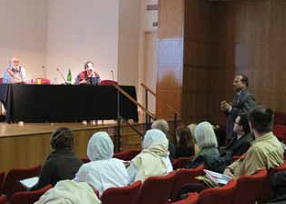
Ashok Jain
In portrayals of bhaṭṭārakas today, it is often the case that an emphasis is placed on their worldly involvement, on their clerical and administrative roles, on the many consecrations that they have performed, and on their role in manuscript and scroll conservation. As compared with Digambara munis, who properly observe monastic discipline, they are considered lax. However, Tillo Detige (University of Ghent) maintains that in earlier times, when there were only a few Digambara munis roaming, the bhaṭṭārakas were held in high esteem by the community and were accorded the same respect and devotion as munis are today. In paṭṭāvalīs, lineages of bhaṭṭārakas were legitimized by linking them with earlier ācāryas and ultimately to the gaṇadharas and to Mahāvīra himself. In vernacular bhaṭṭāraka gītās, they were praised using the same epithets as munis are in rituals of worship today. Furthermore, there is ample evidence of the worship of deceased bhaṭṭārakas from commemorative pavilions (bhaṭṭāraka chatrī) and footprint images (caraṇa pādukās), and there are pūjā texts for the eight-fold worship of these bhattāraka pādukās. Detige also pointed out that bhaṭṭārakas were not all alike and that some appear to have been more ascetically inclined than others. He believes that the more negative appraisal of bhaṭṭārakas today may be associated with an internalisation by the Digambara community as a whole of the critique of the bhaṭṭārakas advanced by the Digambara Terāpanthīs, which commenced in the seventeenth century.
Luitigard Soni (Innsbruck) discussed the role of narratives in rituals of heroic deaths. Among Digambaras, Jain views of death and dying are found in the Ārādhanā texts, such as the Bhagavatī-Ārādhanā, which some have dated to the first century CE. Here various methods of dying are described, along with details regarding the implementation of the various modes of heroic death and the importance of maintaining a proper state of mind, characterized by detachment and self-restraint. For a person who does not carry out these rituals in isolation, there is usually a superintendent who oversees the process. A person may also be supported by the presence of fortyeight monks, and from among them four are appointed to narrate religious stories from the Ārādhanā-kathā-kośas, which detail the manner in which heroic individuals faced death. In these end-of-life hagiographies, the hero often faces death in situations that are more extreme than the aspirant is experiencing, as in stories of those who died unassisted in solitude. They serve as a reminder that the aspirant has the assistance of other monks to rely on throughout the dying process when food and water have been renounced. Instead, he has drink in the form of stories, food in the form of advice, and medicine in the form of his own meditation, which protect him from lapses in his equanimity. More surprising, however, are four exemplary stories of renouncers who, when confronted with circumstances in which it is impossible to follow the right path, take their lives by other means. Under certain circumstances, for example, when a monk is presented with a situation where his vow of chastity would be compromised or where the entire mendicant community would be defamed, it is permissible to suddenly end one's life by entering the body of dead animal to be eaten by vultures, by hanging, by the use of weapons, and so forth. Under such circumstances, as illustrated by these stories, ending one's life in this manner is acceptable and does not preclude the attainment of heaven in the next rebirth.

The workshop concluded with a joint presentation by Peter Flügel (SOAS) and Kornelius Krümpelmann (SOAS) on Johannes Klatt's Jaina Onomasticon and the on-going Leverhulme Trust funded project at SOAS to publish a print edition of this 5,338 page manuscript. Flügel provided a brief account of Klatt's life. After studying Sanskrit and Prakrit, he worked as a librarian at the Royal Library at Berlin, where he catalogued hundreds of manuscripts. He also had access to manuscripts, catalogues, and periodicals housed in other European libraries, and he borrowed manuscripts from India as well. Born in 1852, he labored on his magnum opus for ten years before becoming ill in 1892. Because there has been considerable advancement in scholarship on Jainism since the second half of the nineteenth century, one finds factual errors in the sources which he recorded. He demonstrated at the hand of the references to Loṅkā that the text was not only an important document for the history of Indology but a yet unsurpassed reference work. Krümpelmann observed that it is a valuable source for the names of people and places, titles of texts, names of gacchas, and so forth, and the scholarship on them prior to the twentieth century. Also, old manuscript catalogues are not easy to consult because they lack indexes. Thus, his Onomasticon serves as index of works and authors in catalogues and reports prior to 1893. In preparing the manuscript for publication, there is an emphasis on making it more accessible, with headings transcribed in roman, and there are corrections of misspellings and amendments to the text. Although Klatt references the author and date of his secondary sources and refers to manuscripts and printed editions of primary sources, there is no bibliography in his manuscript. Thus, the extensive bibliography that is being prepared will be indispensable to scholars who consult this work.
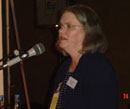 Kristi L. Wiley
Kristi L. Wiley